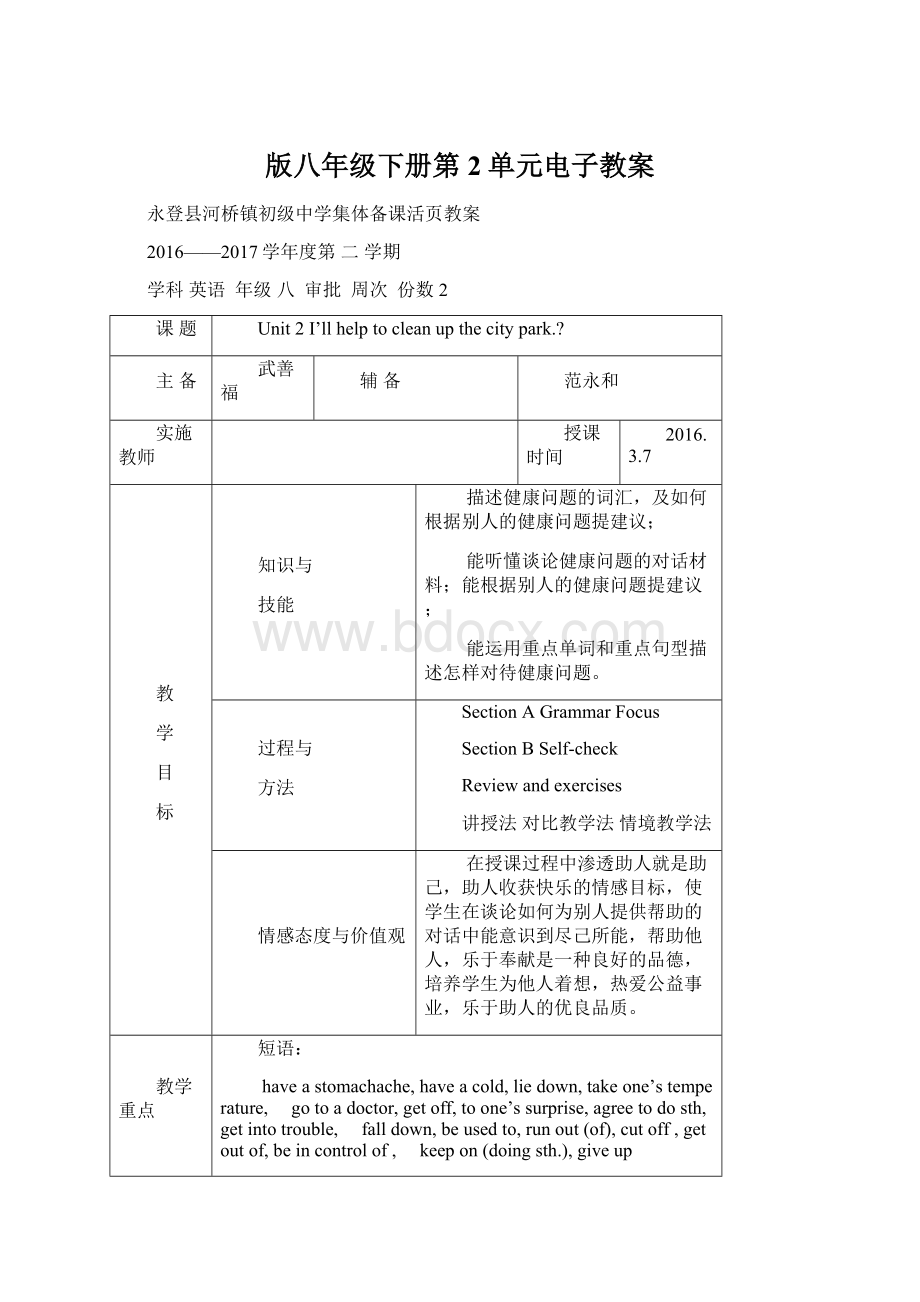版八年级下册第2单元电子教案.docx
《版八年级下册第2单元电子教案.docx》由会员分享,可在线阅读,更多相关《版八年级下册第2单元电子教案.docx(21页珍藏版)》请在冰豆网上搜索。

版八年级下册第2单元电子教案
永登县河桥镇初级中学集体备课活页教案
2016——2017学年度第二学期
学科英语年级八审批周次份数2
课题
Unit2I’llhelptocleanupthecitypark.?
主备
武善福
辅备
范永和
实施教师
授课时间
2016.3.7
教
学
目
标
知识与
技能
描述健康问题的词汇,及如何根据别人的健康问题提建议;
能听懂谈论健康问题的对话材料;能根据别人的健康问题提建议;
能运用重点单词和重点句型描述怎样对待健康问题。
过程与
方法
SectionAGrammarFocus
SectionBSelf-check
Reviewandexercises
讲授法对比教学法情境教学法
情感态度与价值观
在授课过程中渗透助人就是助己,助人收获快乐的情感目标,使学生在谈论如何为别人提供帮助的对话中能意识到尽己所能,帮助他人,乐于奉献是一种良好的品德,培养学生为他人着想,热爱公益事业,乐于助人的优良品质。
教学重点
短语:
have a stomachache, have a cold, lie down, take one’s temperature, go to a doctor, get off, to one’s surprise, agree to do sth, get into trouble, fall down, be used to, run out (of), cut off , get out of, be in control of , keep on (doing sth.), give up
句型:
1. What’s the matter?
I have a stomachache.
You shouldn’t eat so much next time.
2.What’s the matter with Ben?
He hurt himself.
He has a sore back. He should lie down and rest.
3.Do you have a fever?
Yes, I do. No, I don’t. I don’t know.
4.Does he have a toothache?
Yes, he does.
He should see a dentist and get an X-ray.
5.What should she do?
She should take her temperature.
6.Should I put some medicine on it?
Yes, you should No, you shouldn’t.
教学难点
掌握情态动词should \shouldn’t. 的用法
学习have的用法
预习要求
复习情态动词的用法
学法指导
小组合作探究法
教学方法
讲授法对比教学法情境教学法
教具准备
教学图片和视频录音机磁带多媒体课件
教学课时
5
第一课时
课题
Section A 1 (1a – 2d)
教学过程
教师活动
学生活动
Step1Warmingup
1.播放学生志愿者进行义务帮助别人的活动视频,通过询问他们以下问题来引导学生们了解社会上一些的志愿们进行的活动。
T:
Whoarethey?
S:
They’revolunteers.Theyusuallyvolunteertohelpothers.
T:
Howcouldwehelppeople?
S1:
Wecouldcleanuptheparks
S2:
Wecouldhelpsickpeopleinthehospital.
S3:
Wecouldhelpplanttrees.
Step2Newwords
1.cityn.城市
e.g.Thelibraryisinthenorthofthecity.
2.noticen.公告牌;通告;布告
e.g.Pleasereadthelistonthenoticeboard.
3.signn.标志;信号
e.g.Lookaround,wecouldseenosignoflife.
环顾四围,我们看不出一点生命的迹象。
4.volunteerv.义务劳动,自愿做
volunteertodosth.义务自愿做某事
e.g.Manypeoplevolunteertoworkonthefarm.
5.cleanup打扫;清除
e.g.Thestudentstaketurnstocleanuptheirclassroom.
6.giveout分发;散发
e.g.Pleasehelpmegiveoutthesetestpapers.
7.cheerv.欢呼;喝彩
e.g.Cheerup.Thenewsisn’ttoobad.
8.lonelyadj.孤独的;寂寞的
e.g.Idon’tfeellonelybecauseImadenewfriendshere.
我不觉得孤独因为我交了新朋友。
9.usedto曾经,过去
e.g.Jackusedtobeshort,butnowhe’stall.
Step3Discussion
1.1a.Lookatthewaysyoucouldhelpothers.Thenlistotherways.
2.Ssdiscusswiththeirpartnersandwritethewaysonecouldhelpothers:
①Helptoplanttreesbytheriver.
②Helptocleanupthecitypark.
③Visittheoldpeopleintheoldpeople’shome.
④HelpyoungkidstolearnEnglish.
Step4Listening
1.T:
TellSstoreadthesentencesinthechart.Makesuretheyknowthemeaningofthesentences.
2.1b.PlaytherecordingfortheSstolistenandnumberthewaystheboyandgirlcouldhelpothers.
Step5Pairwork
1.1c.Usetheinformationinthechartof1btomakeotherconversations.
A:
Ihopetoworkoutside.
B:
Youcouldhelptocleanupthecityparks.
Step6Listening
1.2a:
T:
AgroupofstudentsareplanningaCityParkClean-upDay.Listenandcheck(√)thethingstheyaregoingtodototellpeopleaboutit.
1.Lookatthepicturesin2a.Discussthethingstheyaregoingtodo.
2.PlaytherecordingfortheSstolistenandcheckthepictures.
3.Playtherecordingagaintochecktheanswers.
2.2b:
1.ExplainsomemainsentencesfortheSs.Makesuretheyknowwhattodo.
2.PlaytherecordingfortheSstowritethecorrectwordsintheblanks.
1.Weneedto____________aplantotellpeopleaboutthecityparkclean-up.
2.Clean-upDayisonlytwoweeksfromnow.Wecan’t______makingaplan.
3.Wecould______signs.
4.Let’smakesomenotices,too.ThenI’ll____them____afterschool.
5.Wecouldeach_______10studentsandaskthemtocome.
3.Playtherecordingagaintochecktheanswers.
Answers:
1.comeupwith2.putoff3.putup4.hand,out5.callup
Step7Pairwork
1.2c.TellSstomakeaconversationusingtheinformationin2aand2b.
2.e.g.
A:
WeneedtocomeupwithaplanfortheCityParkClean-UpDay.
B:
Let’shavelunchfirst.
A:
No,weneedtostartnow.Clean-UpDayisonlytwoweeksfromnow.
B:
You’reright.Wecan’tputoffmakingaplan.Aswetalk,I’llwritedownallourideas.Thenwecandecidewhichideasarebest.
A:
Let’smakesomenotices,too.ThenI’llhandthemoutafterschool.
B:
Andwecouldeachcalluptenstudentsandaskthemtocome.
3.Asksomepairstoactouttheirconversations.
Step8ReadingandRole-play
1.Readtheconversationsandanswerthetwoquestions:
①Where’sHelengoingtoworkthissummer?
②WhatdidTomdotohelptheoldpeople?
Answers:
She’sgoingtoworkinanoldpeople’shome.Readingthenewspaperorjusttalkingtotheoldpeople.
2.Readtheconversationaftertheteacher.
Step9Languagepoints
1.Theytoldmestoriesaboutthepastandhowthingsusedtobe.usedtodosth.过去常常做某事;表示过去习惯性、经常性的动作或状态,暗指现在已经不存在。
used无人称和时态的变化。
e.g.IusedtogototheYouthCenter.ButIhavenotimenow.
我过去经常去青少年中心,但现在我没有时间了。
Grandparentsusedtotellusstorieswhenwewereveryyoung.
在我们小时候祖父母常给我们讲故事听。
2.Yeah,alotofoldpeoplearelonely.
lonelyadj.孤独的;寂寞的指精神上感觉孤独、寂寞。
e.g.Theoldmanfeelslonely,soheraisesadog.
那名老人觉得很孤独,因此他养了一只狗。
3.WeneedtocomeupwithaplanfortheCityParkClean-upDay.
need用作实义动词,有“必要”、“必需”之意,有人称、数和时态的变化,可以接名词、代词、动名词或带to的动词不定式作宾语。
e.g.ThemanneedsanEnglishdictionarywhenheworks.
这个人在工作时需要一本英语词典。
Doyouneedtoseehimyourself?
你必需亲自见他吗?
4.cleanup意为“打扫;清理”。
但如果在clean和up间加个连字符号,它就是名词了,意为“扫除”。
e.g.Youmustgiveyourclassroomagoodclean-up.你必须对教室进行彻底地打扫。
comeupwith提出(观点,看法)。
e.g.Hehas comeupwith agreatidea.他想出了一个绝好的办法。
Icameupwithabetterplanthanthat. 我提供了一个比那还好的计划。
Learn:
new words and phrases.
Listen to the conversations
Make conversations
Listening
LetSsreadtheconversationinthepicture.
Letsomepairsactouttheirconversations.
LetSsreadthesentencesbelow.
Letonepairtoreadouttheirconversationfirst.
LetSsacttheconversationinpairs.
LetSsPracticetheconversationwiththeirpartner.Thenletsomepairstoactouttheconversation.
作业
Homework:
Ⅰ.Choosethecorrectanswers.
1.Itookhertotheconcertto____.
A.cheerupherB.cheerherupC.cheersheup
2.Let’shelp___foodatthefoodbank.
A.togiveoutB.giveupC.givingout
Ⅱ.Completethesentences.
1.You’dbetter____________(想出)abetterplan.
2.Whowill_________________(自愿回答)thisquestion?
3.Youcouldputupa______(布告)here.
4.Withnoonetotalkto.He_____very______(感觉很孤独).
5.Thelife___________(曾经是)veryinterestinginmyschooldays.
板书设计
Summary
1.usedtodosth.过去常常做某事;表示过去习惯性、经常性的动作或状态,暗指现在已经不存在。
used无人称和时态的变化。
2.need用作实义动词,有“必要”、“必需”之意,有人称、数和时态的变化,可以接名词、代词、动名词或带to的动词不定式作宾语。
noticen.公告牌;通告;布告
e.g.Pleasereadthelistonthenoticeboard.
3.signn.标志;信号
e.g.Lookaround,wecouldseenosignoflife.
环顾四围,我们看不出一点生命的迹象。
4.volunteerv.义务劳动,自愿做
volunteertodosth.义务自愿做某事
课后反思
第二课时
课题
Section A 2 (3a – 3c)
教学过程
教师活动
学生活动
Step1Revision
1.Writedownthephrases.
1.打扫________2.分发________
3.曾经_______4.(使)变得高兴________5.义务做某事_____________
6.大打扫日______7.想出主意(办法)____
2.Role-play
A:
Hi,Tom.I’mmakingsomeplanstoworkinanoldpeople’shomethissummer.
B:
Really?
Ididthatlastsummer!
Step2Newwords
1.severalpron.adj.(=some)几个;数个;一些2.feelingn.感触;感觉;感情;feel(v.)+ingfeeling
e.g.Hehadtolowerhisvoicetocontrolhisfeeling.
他不得不压低声音来控制自己的感情。
3.satisfactionn.满足;满意
e.g.Lookingatabeautifulpaintingalwaysgivesonesatisfaction.
观看一幅美丽的图画总会使人心满意足。
4.joyn.高兴;愉快
e.g.It’sdifficulttodescribemyjoyinwords.
难以用语言来描述我的快乐。
5.ownern.物主;主人
e.g.Theydecidedtogivethecatbacktotheowner.
他们决定将猫归还它的主人。
6.journeyn.旅行;旅程
Step3Warmingup
1.Watchavideoandanswerthequestions.
1.Wheredidtheyvolunteertowork?
2.Whatdidtheydothere?
3.Whatdoyouusuallydoonyourfreetime?
Wouldyouliketovolunteertodoanythingforothers?
Sstrytoanswerthequestions:
1.Theyvolunteeredtoworkattheoldpeople’shome.
2.Theymadedumplingsfortheoldpeople.Theycleaneduptheirrooms.Theytalkedwiththeoldpeople.Theysanganddancedfortheoldpeople.…
Step4Reading
1.3a:
1.TellSstoreadthearticlein3aquicklyandtrytofindtheanswerstothesequestions:
1.WhatdoesMariolove?
2.WhatdoesMarylove?
3.WhatdoMarioandMaryvolunteertodo?
2.3b:
Readthearticleagainandanswerthequestions.
1.WhydoesMariovolunteertohelpothers?
2.WhydoesMaryvolunteertohelpothers?
3.WhatdoesMariosayaboutvolunteering?
4.WhatdoesMarysayaboutvolunteering?
3.3c
1.Mariowouldlike_____ananimaldoctor.
2.Marioworksforananimalhospitalbecausehewants________abouthow_______foranimals.
3.Marydecided________forajobatanafter-schoolreadingprogramlastyear.Shestillworkstherenow_______kidslearntoread.
4.Maryhasadreamjobbecauseshecandowhatsheloves____________.
Step5Languagepoints
1.MarioGreenandMaryBrownfromRiversideHighSchoolgiveupseveralhourseachweektohelpothers.
fromRiverHighSchool为介词短语作后置修饰语,翻译时应提前。
tohelpothers作目的状语。
是“每周拿出几个小时”的目的。
2.Mariobelievesitcanhelphimtogethisfuturedreamjob.
马里奥相信这会帮助他获得他的梦想职业。
help